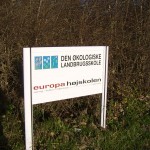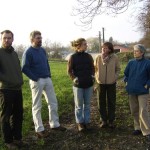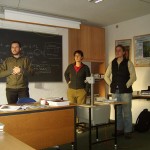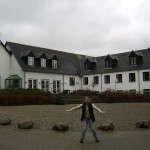From West Jutlands High School we traveled by bus to the city of Arhus, and then on to The Organic Agricultural College or Den Økologiske Landbrugsskole på Kalø near Rohne. This school, besides being a foreign language “high school”, also offers a three year certificate in Organic Farming, and trains about sixty students per year in organic grain crops, pigs, or cows for dairy or meat. Kristian, the school’s principal, took us on a tour of the campus. The fields of Brassicas as a catch crop, functioning dairy, and marsh sewage treatment plant treating all of the schools wastewater were only some of the great projects the school was involved in. Students attend classes for five months, then have twelve months of on-farm experience, then another six months of class work. They must already have at least one year farming experience before they can be accepted to the school, and the program is, essentially, free. The certificate earned by the end of the program is somewhere between an associate’s degree and a bachelor’s degree, and a person must have one of these certificates if they want to buy a farm that is more than thirty hectares in Denmark.
We attended two international classes — about half of the student body is from Eastern Europe, mostly Poland, Bulgaria, and Ukraine, with the other half from Denmark. The International classes are all in English. The first class we attended was a lecture in a unit about crop rotation for first term students. The crops in question were mostly large area commodity crops such as sunflowers, canola, rye, spelt, etc. To this class of about seventeen we gave an impromptu lecture about our project. We focused on why we believe open pollinated seeds are important, with issues of food security and biodiversity stressed. We took a detour from the school for the rest of the morning and walked three miles out to “the ruin,’’ a several hundred year old fort on a small island that is connected to the mainland by a man-made jetty. It was quite beautiful, and a nice walk to boot, past a small marina and around an inlet of the bay. Andrew even found some wild yarrow seeds to collect.
Later in the day we attended another class, one of only twelve lectures the students receive in growing vegetables and horticultural crops instead of industrial organic commodity crops. To this class we also presented about our project, but this time we focused on the differences between open pollinated and hybrid crops. Most of the students in the class indicated that they had had some experience growing food in their own gardens at home, but no experience whatsoever with growing vegetable crops on a farm scale. Perhaps more interestingly, though, is that they also indicated that it was their first time even hearing the words “hybrid´´ and “open-pollinated´´ (!?!). It seemed to go pretty well, and we had a good time altering our message to the audience.
Through conversations with the teachers at this school we learned that organic agriculture in Denmark has very limited markets. While a large percentage of the population eats organic foods, many people only obtain these organic foods at the grocer’s, and so small organic market gardens like we have in the Pacific Northwest are very uncommon. For this reason organic vegetable growers generally must grow only one or two different crops, and a large enough amount of them to wholesale to the supermarkets. For example, one farm in Denmark supplies the entire country with organic carrots. Part of the reason for this may be the limited crops that grow well here. In the summer they can grow potatoes, carrots, beetroot, celeriac, green kale, cabbage, and horseradish, and indeed these are the basic vegetables of the classic Danish diet. If a farmer wanted to start a CSA they would have a very limited selection of crops to offer, and/or would be forced to use a lot of plastic and greenhouses. On Wednesday night we attended a concert of “Nordic Jazz”, inspired by the Matisse book, “Jazz.” The two-piece group was more experimental than any jazz group I have ever seen before — a little bit of alto sax, a stand-up bass that was played sometimes as a cello, an electric guitar, lots of looping and crazywierd vocal effects, set to a slideshow of Matisse paintings. Very odd, and also very good.




Leave a Reply